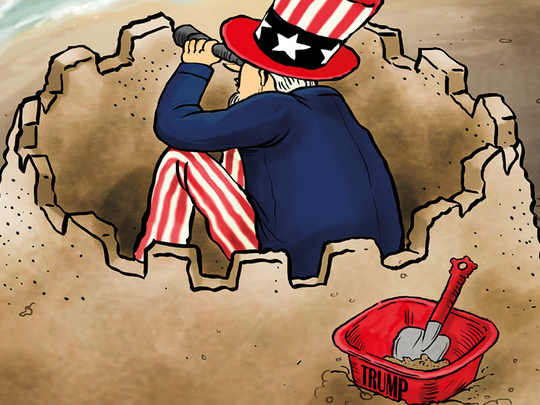
Nikki Haley, America’s Ambassador to the United Nations, has come to represent the grim face of a dysfunctional American foreign policy whose main feature is growing isolation in the international arena. Her image as she raised her hand at the UN Security Council session on occupied Jerusalem’s status last December 18, thus vetoing a draft resolution that was supported by 14 out of 15 members, underlined the new administration’s unilateral approach to world crises in stark contrast to the multilateral behaviour followed by previous residents of the White House — both Republican and Democrat — in the last two-and-a-half decades.
It happened again — this time at a larger scale — at the UN General Assembly three days later, on December 21, when an overwhelming majority of nations, 128, voted for a resolution that tacitly rebuked United States President Donald Trump’s recognition of occupied Jerusalem as Israel’s capital. The US voted against, along with eight other members made up almost entirely of remote and little-known island nations. But before the vote was made bitter and undiplomatic, Haley made direct threats to countries supporting the resolution, in addition to the UN itself, saying the US will be watching, taking names, adding that America will not forget this day!
Now the US finds itself at odds once more with the international community over funding, or defunding, United Nations Relief and Works Agency (UNRWA), the UN agency responsible for millions of Palestinian refugees. It is seen as one of a number of steps to decrease US financial support for the UN as a whole. And earlier, the US had decided to withdraw from Unesco over the latter’s anti-Israel stance.
But it is not only over Israel that the US finds itself distanced from its traditional allies such as Canada, Australia, the United Kingdom and the European Union (EU). On January 5, the UN Security Council (UNSC) met again, at Haley’s request, to discuss the protests in Iran and the government’s crackdown. But again Haley found herself alone in condemning Tehran’s reaction to the protests, with the French and the Russians saying that the UNSC was not the right venue to discuss an internal issue of a member state, which does not constitute a threat to international peace and security.
That meeting signalled the new reality of American foreign policy; one that seeks to force its own agenda on long-time partners and allies with little notice to diplomatic tactfulness and long-term strategic goals. The rift had begun early on with Trump issuing a series of Executive Orders that underlined his “America First” mantra. Whether on international trade, climate change, immigration, or the controversial travel ban, the US was charting its own course without bothering to consult with its own allies and next-door neighbours.
Added to this were Trump’s off-the-cuff statements and late-night tweets on Nato, the UN, terrorism, China’s currency manipulation, the break-up of the EU, the “myth” of global warming, Pakistan’s deceit and many others. Whether Trump and his aides had cultivated an isolationist strategy or were just appealing to the populist base that helped carry the unlikely candidate to the White House is difficult to ascertain. But Trump’s isolationist trend and his simplification of America’s external challenges and its role in a globalised world have little to do with the isolationist doctrines of the 1920s, which emerged following the First World War. Ironically, during that period, the US had passed a number of anti-immigration laws and set high tariffs on imports as well.
Despite election promises to get the US out of Afghanistan and Iraq, Trump had set out to increase troop levels in both countries as well as in northern Syria. His position on the multilateral Iran nuclear agreement is unclear; dubbing it as the worst deal ever negotiated and putting its fate in the hands of Congress. And yet his alternatives on Iran remain vague. As far as we know, he is backing a plan to create a new anti-Iran regional alliance. But what does confronting Iran entail?
Following Russian intervention in Syria, America’s influence in the region appeared to be waning; leaving Washington’s traditional partners — from Turkey to Egypt and from the Gulf states to Jordan — wondering if the US remains a reliable ally.
Under former US president Barack Obama, the US had begun a slow but clear pivot away from the Middle East and towards South Asia. It was only the emergence of Daesh (the self-proclaimed Islamic State of Iraq and the Levant) in Syria and Iraq that delayed that deliberate migration to the East. Trump may have altered such plans. His historic visit to Saudi Arabia, the first to a foreign country as US President, underlined what seemed to be a new American commitment to the region. And until recently, the White House was directly involved in putting together the so-called “the ultimate deal” to end the Israel-Palestine conflict and by extension Arab struggle against Israel.
However, Trump’s decision on occupied Jerusalem appears to have been a culmination of unilateral tendencies, taken mostly to appease a religious voter base and with no regard for its regional fallout, which deliberately or not has put the US on an isolationist path. With no clear foreign policy agenda, and in the absence of a State Department role or influence on the White House, Trump’s mannerisms and impulsiveness will embolden a unilateral approach that will deliver a strange hybrid of isolationism and interventionism. For the region, as well as for the rest of the world, correctly reading Trump’s foreign policy thinking will present a daily challenge!
Osama Al Sharif is a journalist and political commentator based in Amman.









